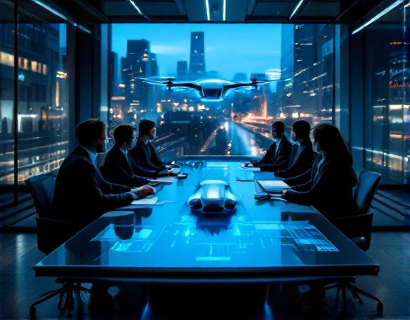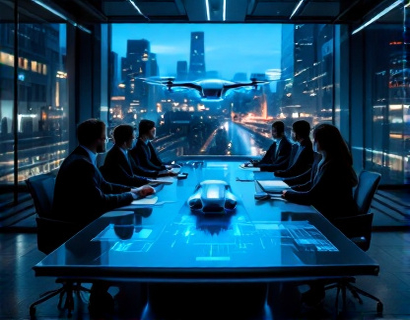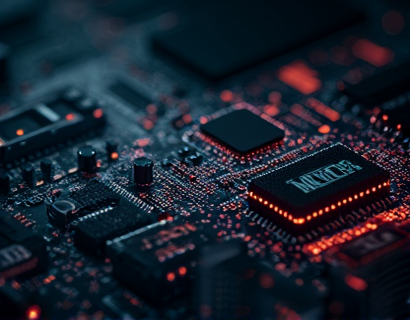AI-Driven Transformation: Revolutionizing Aeronautics with Intelligent Solutions
The aeronautics industry, a cornerstone of modern transportation and commerce, is undergoing a profound transformation driven by artificial intelligence (AI). This shift is not merely an incremental update but a revolutionary overhaul of how operations are managed, decisions are made, and innovations are pursued. AI technologies, from machine learning algorithms to advanced analytics, are reshaping the landscape, offering unprecedented opportunities for efficiency, safety, and sustainability. This article delves into the multifaceted impact of AI on the aeronautics sector, exploring how intelligent solutions are optimizing operations and driving forward-looking innovations.
The Role of AI in Aeronautics
AI's role in aeronautics is multifunctional, touching nearly every aspect of the industry from manufacturing to flight operations. One of the primary areas where AI is making a significant impact is in predictive maintenance. Traditional maintenance schedules are often based on fixed time intervals, which can lead to either over-maintenance or unexpected failures. AI-driven predictive maintenance, however, uses data from sensors and historical records to predict when components are likely to fail, allowing for timely and precise interventions. This not only reduces downtime but also extends the lifespan of aircraft components, leading to substantial cost savings.
Another critical area is flight optimization. AI algorithms can analyze vast amounts of data, including weather patterns, air traffic, and aircraft performance, to determine the most efficient flight paths. This results in reduced fuel consumption, lower emissions, and faster travel times. For instance, AI can dynamically adjust flight routes in real-time to avoid turbulence or congested airspace, enhancing both safety and efficiency. These optimizations are particularly crucial in a global market where fuel costs and environmental regulations are significant concerns.
Enhancing Decision-Making with AI
Decision-making in the aeronautics industry is complex and multifaceted, involving numerous stakeholders and variables. AI enhances this process by providing actionable insights and predictive analytics. For example, AI can analyze market trends, passenger demand, and operational data to forecast future needs and optimize resource allocation. This is invaluable for airlines and manufacturers in making strategic decisions about fleet expansion, route planning, and service offerings.
Moreover, AI-powered decision support systems can integrate data from various sources, such as customer feedback, operational metrics, and regulatory requirements, to provide comprehensive recommendations. This holistic approach ensures that decisions are not only data-driven but also aligned with broader business objectives and regulatory standards. In a sector where safety and reliability are paramount, such insights can be the difference between success and failure.
AI in Air Traffic Management
Air traffic management (ATM) is another area where AI is revolutionizing operations. Traditional ATM systems rely on human controllers and manual processes, which can be prone to errors and inefficiencies. AI-driven ATM solutions use machine learning to predict traffic patterns, optimize airspace usage, and reduce delays. These systems can handle vast amounts of data in real-time, making them far more responsive and accurate than human operators alone.
One notable application is the use of AI for conflict detection and resolution. By continuously monitoring the positions and trajectories of aircraft, AI can identify potential collisions and suggest corrective actions before they become critical. This not only enhances safety but also improves the overall flow of air traffic, reducing congestion and travel times. As the global air travel demand continues to grow, AI-driven ATM solutions will be essential in managing the increasing complexity of airspace operations.
AI in Aircraft Design and Manufacturing
The design and manufacturing of aircraft are also being transformed by AI. Traditional design processes are time-consuming and often rely on human intuition and experience. AI, however, can accelerate this process by simulating countless design iterations and identifying the most efficient and effective solutions. Machine learning algorithms can analyze performance data, material properties, and environmental conditions to optimize aircraft design for factors such as weight, strength, and aerodynamics.
In manufacturing, AI-powered robots and automation systems are enhancing precision and efficiency. These systems can perform complex tasks with high accuracy, reducing the margin of error and improving production speeds. Additionally, AI can monitor the manufacturing process in real-time, detecting anomalies and suggesting adjustments to maintain quality and consistency. This level of precision and control is crucial in an industry where even minor defects can have significant consequences.
AI for Enhanced Passenger Experiences
Beyond operational efficiencies, AI is also transforming the passenger experience in aeronautics. From check-in and security to in-flight entertainment, AI technologies are making travel more convenient and enjoyable. For instance, AI-driven chatbots and virtual assistants can handle customer inquiries, provide personalized recommendations, and assist with bookings and reservations. These interactions are not only faster and more efficient but also enhance the overall customer experience by offering tailored services.
In-flight, AI can optimize the use of resources such as food and beverage supplies based on passenger preferences and historical data. This reduces waste and ensures that passengers have access to their preferred options. Additionally, AI-powered entertainment systems can adapt content recommendations to individual preferences, creating a more personalized and engaging experience.
Challenges and Considerations
While the benefits of AI in aeronautics are clear, there are also challenges and considerations that must be addressed. One of the primary concerns is data security and privacy. The aeronautics industry handles sensitive information, and ensuring the integrity and confidentiality of this data is critical. Implementing robust cybersecurity measures and adhering to strict regulatory standards are essential to mitigate these risks.
Another challenge is the need for skilled professionals who can develop, implement, and maintain AI systems. The aeronautics industry must invest in training and development programs to build a workforce capable of leveraging AI technologies effectively. Collaboration between industry players, academic institutions, and technology providers will be key in addressing this skills gap.
Regulatory frameworks also play a crucial role. As AI technologies evolve, regulations must adapt to ensure safety, reliability, and ethical use. Industry stakeholders must work closely with regulatory bodies to develop guidelines that balance innovation with safety and public trust. This collaborative approach will help accelerate the adoption of AI while maintaining high standards.
Future Prospects
The future of AI in aeronautics is promising, with ongoing research and development poised to unlock even more innovative solutions. One area of focus is the integration of AI with other emerging technologies such as the Internet of Things (IoT), blockchain, and quantum computing. These synergies can lead to more sophisticated and integrated systems, further enhancing efficiency and safety.
For example, the combination of AI and IoT can create smart aircraft that continuously monitor and optimize their own performance. Blockchain can ensure secure and transparent data sharing among stakeholders, while quantum computing can solve complex optimization problems that are currently infeasible with traditional computing methods. These advancements will not only improve operational efficiency but also pave the way for new business models and services.
Moreover, the environmental impact of the aeronautics industry is a growing concern, and AI can play a pivotal role in sustainability efforts. By optimizing flight paths, reducing fuel consumption, and improving maintenance practices, AI can significantly lower the carbon footprint of air travel. As the world increasingly focuses on sustainable practices, AI-driven solutions will be essential in meeting these goals.
Conclusion
The integration of AI in the aeronautics industry is not just a trend but a transformative force reshaping the future of aviation. From predictive maintenance and flight optimization to enhanced decision-making and passenger experiences, AI is driving innovation and efficiency across the board. As the industry continues to evolve, embracing AI will be crucial for businesses looking to stay competitive and sustainable in a rapidly changing world. By leveraging intelligent solutions, aeronautics companies can not only optimize their operations but also contribute to a safer, more efficient, and more sustainable future for air travel.










































